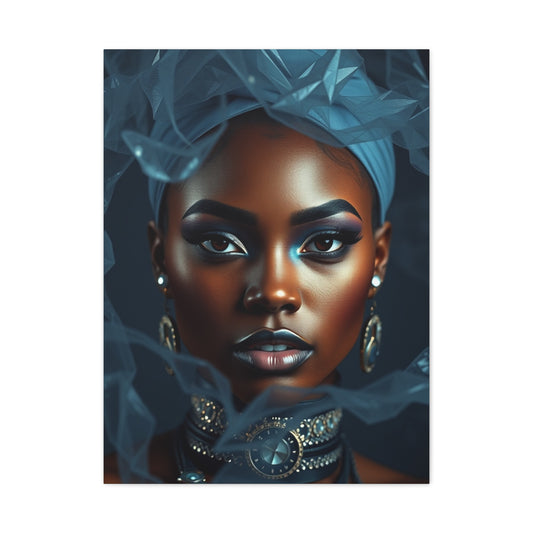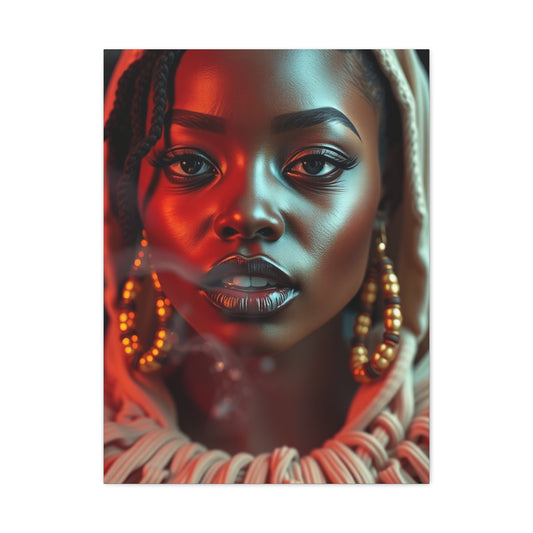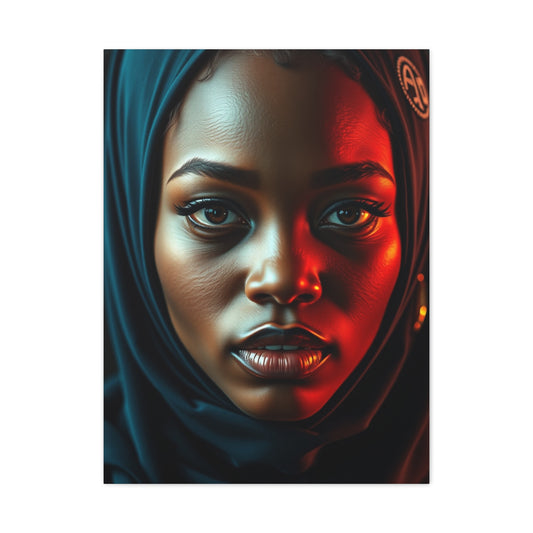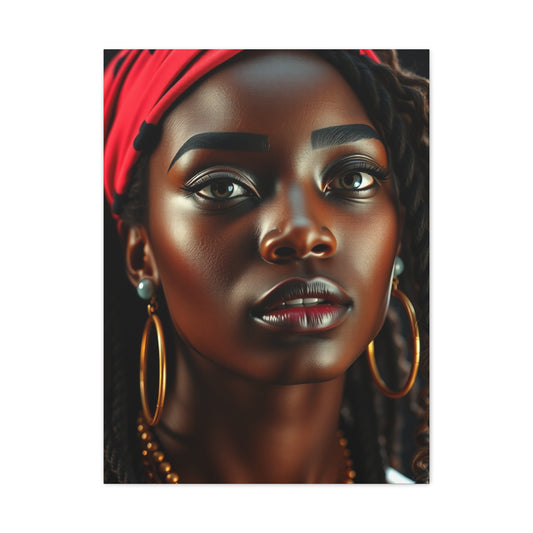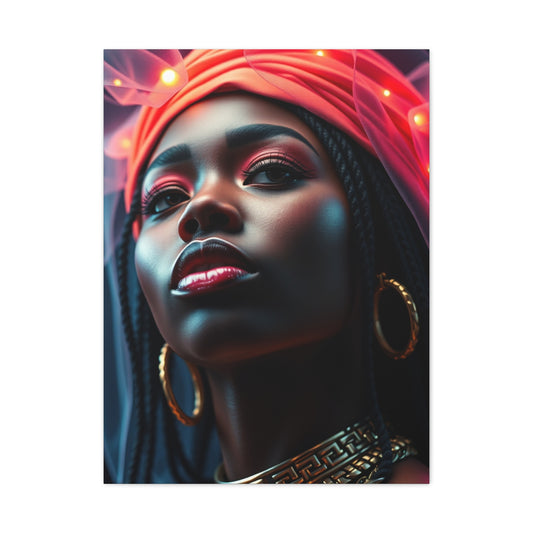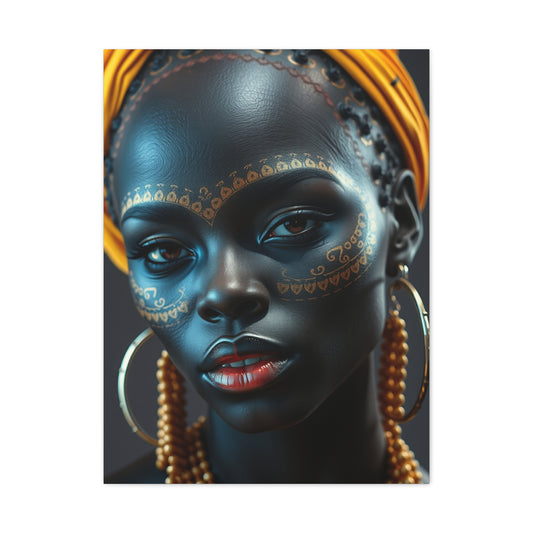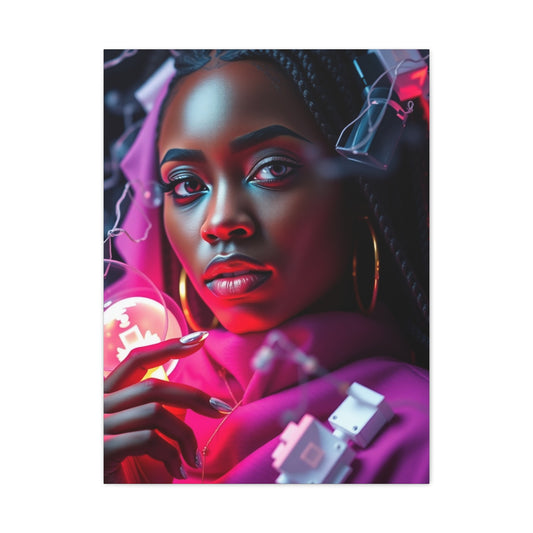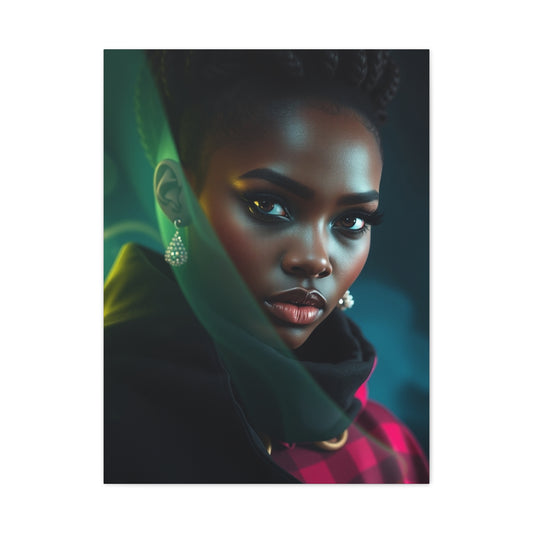Brazilian Muralist Criola Celebrates Afro-Brazilian Heritage Through "Black Girl Magic Wall Art" Mural in Las Vegas
The vibrant landscape of contemporary street art has emerged as a global forum for cultural dialogue, self-expression, and social commentary. Across cities worldwide, murals and public art installations are no longer mere decorative additions to urban infrastructure; they have become powerful tools for storytelling, community engagement, and cultural preservation. Within this dynamic sphere, Brazilian muralist Criola has carved out a distinctive space as a champion of Afro-Brazilian identity and Black feminine power. Her recent “Black Girl Magic wall art” mural in Las Vegas exemplifies her unwavering commitment to honoring heritage while inspiring audiences through visual storytelling.
Criola’s work transcends traditional artistic boundaries, blending the aesthetic allure of vivid color with profound narratives rooted in Afro-Brazilian culture. She draws inspiration from a rich tapestry of sources, including the natural world, ancestral traditions, metaphysical inquiry, and the lived experiences of Black women navigating societal challenges. Every element of her compositions—be it the flowing lines of a figure, the interplay of light and shadow, or the layering of symbolic motifs—is carefully orchestrated to evoke emotional resonance and intellectual engagement. Through this approach, Criola invites viewers not just to observe, but to reflect, connect, and participate in a broader conversation about identity, resilience, and empowerment.
The “Black Girl Magic wall art” mural in Las Vegas stands as a monumental celebration of Black feminine energy and creativity. It pays homage to the strength, beauty, and cultural contributions of Black women, while also recognizing the struggles and triumphs that define their collective experience. Criola’s artistic philosophy emphasizes the intersection of personal narrative and cultural history; the mural functions as both a tribute and a declaration. By embedding elements that reference spiritual awakening, ancestral knowledge, and Afro-Brazilian cultural motifs, she creates a visual lexicon that resonates deeply with viewers from diverse backgrounds. This approach highlights not only the aesthetic brilliance of her work but also its role in fostering cultural literacy and communal pride.
Criola’s dedication to Afro-Brazilian representation is inseparable from her personal journey. As a woman confronting structural inequalities and navigating societal biases, her art embodies a form of resistance, empowerment, and reclamation. Each mural is a manifestation of her lived experience, a dialogue between past and present, and a means to elevate narratives that are too often marginalized in mainstream discourse. In celebrating her matriarchal lineage and the collective power of Black women, Criola reinforces the significance of visibility, affirmation, and cultural continuity in public spaces.
Downtown Las Vegas Transformation Through Monumental Public Art
The bustling urban core of downtown Las Vegas has undergone a vibrant cultural metamorphosis, largely fueled by the infusion of monumental public art. Among the most striking recent contributions is the work of Brazilian muralist Criola, whose ambitious project debuted during the internationally celebrated Life is Beautiful Festival. Over the course of this three-day cultural extravaganza, the city’s streets became a dynamic gallery where Criola unveiled her extraordinary diptych titled "Black Girl Magic." The artwork quickly became a focal point for festival attendees and local residents, capturing attention with its bold imagery, vivid colors, and profound narrative rooted in Afro-Brazilian heritage.
Strategically positioned in a high-traffic area of downtown, Criola’s mural does more than decorate—it transforms. Its placement in the city’s heart underscores a growing recognition that street art is not merely decorative but a legitimate, transformative cultural expression. Public murals like "Black Girl Magic" engage communities in ways that traditional gallery exhibitions cannot. By situating art in accessible, everyday spaces, Criola ensures that her message—one of empowerment, representation, and cultural pride—reaches a wide and diverse audience. Pedestrians, commuters, and visitors encounter the artwork organically, sparking reflection, conversation, and, at times, collective inspiration.
The Life is Beautiful Festival itself has become an influential platform for contemporary artists, offering an unparalleled opportunity to engage with large, heterogeneous audiences. The festival’s commitment to large-scale, site-specific installations allows creators like Criola to explore themes of identity, social justice, and community connection in public spaces. In doing so, it challenges the traditional boundaries of art consumption, inviting viewers from all walks of life to engage with artistic narratives that might otherwise remain confined to galleries or academic circles.
Moreover, the festival fosters dialogue around cultural representation and equity in public spaces. Criola’s work exemplifies this ethos by centering Afro-Brazilian experiences, celebrating diversity, and highlighting stories that have historically been marginalized. The mural’s scale and visibility reinforce the democratization of art, making complex cultural conversations part of the urban experience. It stands as both a visual spectacle and a social statement, illustrating the power of public art to reshape perceptions, elevate community pride, and infuse everyday city life with meaning.
Ultimately, the transformation of downtown Las Vegas through projects like Criola’s demonstrates how public art can redefine urban landscapes. By merging creativity with social consciousness, murals such as "Black Girl Magic" enrich the cultural fabric of the city, leaving an enduring impact that extends well beyond the festival itself.
Visual Narrative of Empowerment and Cosmic Connection
The "Black Girl Magic" diptych by Brazilian muralist Criola stands as a compelling visual narrative that celebrates the profound strength, creativity, and spiritual resonance of Black femininity. At the heart of this work, viewers are greeted by a central figure whose presence is at once commanding and graceful. She emerges from the urban wall as if stepping into the public consciousness itself, embodying dignity, poise, and self-assured confidence. Her gaze is steady and contemplative, inviting the audience to reflect not only on her individuality but also on the collective experiences and resilience of Black women. The figure’s posture, expression, and compositional prominence signal empowerment in its most authentic form—a quiet yet undeniable assertion of identity and presence.
One of the most striking features of the mural is the imaginative depiction of the subject's hair, which extends into a dynamic constellation of shapes, colors, and cosmic energy. Criola transforms this traditionally personal element into a visual metaphor for intellectual and creative power. The hair becomes a symbolic universe, each curl and strand radiating ideas, innovation, and inspiration. The effect is reminiscent of stars scattered across the night sky, suggesting that the thoughts and potential of Black women are luminous, infinite, and interwoven with the broader cosmos. Through this technique, Criola emphasizes that empowerment is not merely physical or aesthetic—it is deeply intellectual, spiritual, and boundless.
The artist’s deliberate choice of color further amplifies the mural’s symbolic resonance. Rich purples evoke spiritual depth and dignity, golden yellows radiate warmth and optimism, electric blues suggest intelligence and clarity, and earthy browns anchor the figure in natural authenticity. This chromatic harmony balances energy with grounding, celestial with earthly, creating a multidimensional portrait that transcends conventional representation. The mural moves beyond simple portraiture, presenting the subject as an archetype of Black feminine power—a universal figure whose energy extends far beyond the immediate space of the wall.
Cultural Significance and Representation in Contemporary Art
Criola’s artistic practice stands as a deliberate and profoundly meaningful intervention in the landscape of contemporary art, directly addressing the historical underrepresentation of Black women in mainstream artistic discourse. Throughout history, art institutions and popular culture have largely centered Eurocentric ideals of beauty and power, often marginalizing or misrepresenting Black feminine identities. Criola’s decision to center Black women in her work is not merely aesthetic; it reflects a conscious and intentional effort to rewrite these cultural narratives, providing visibility and recognition to a community that has long been excluded from positions of prominence in both public and private artistic spaces.
Her approach to representation transcends the notion of mere visibility. By portraying Black women in moments of strength, dignity, and grace, Criola challenges pervasive stereotypes and societal biases that have historically diminished Black femininity. Her work frames Black women as subjects of reverence and admiration, highlighting their intellectual, creative, and spiritual contributions. This emphasis on empowerment and honor functions as a form of cultural reclamation, transforming public spaces into sites of celebration and acknowledgment. In doing so, Criola not only amplifies individual stories but also reinforces collective cultural identity, positioning Black feminine experience as integral to contemporary artistic discourse rather than peripheral to it.
The concept of "Black Girl Magic," which inspires much of Criola’s work, has grown into a powerful cultural phenomenon that celebrates the unique combination of resilience, creativity, intelligence, and spiritual vitality that characterizes Black feminine experience. By translating this concept into large-scale murals and public art installations, Criola bridges the gap between personal empowerment and collective visibility, allowing these narratives to resonate broadly within urban landscapes. Her murals serve as daily reminders to viewers of the enduring strength and beauty of Black women, while simultaneously contributing to a broader societal shift in how Black femininity is perceived and valued.
Furthermore, Criola’s work exemplifies the transformative potential of public art as a medium for cultural dialogue. By embedding these empowering images within cityscapes, she fosters spaces where marginalized voices are acknowledged and celebrated, inviting viewers to confront and reconsider long-standing cultural assumptions. In essence, Criola’s artistic practice is not just about representation; it is a cultural intervention that redefines contemporary visual storytelling, challenges entrenched biases, and celebrates the power and magic inherent in Black feminine identity.
Ancestral Wisdom and Matriarchal Strength
The thematic core of Criola’s work is profoundly informed by her personal connection to ancestral wisdom and the enduring power of matriarchal structures. From an early age, she was immersed in a family environment dominated by strong Black women who exemplified resilience, determination, and leadership in the face of systemic oppression. These formative experiences cultivated within her a deep appreciation for the sacrifices, perseverance, and fortitude of the generations that came before her. In turn, this appreciation became a central lens through which she perceives and creates art, situating her practice within a broader continuum of intergenerational knowledge and cultural memory.
Criola’s engagement with ancestral wisdom manifests in her work through deliberate aesthetic and symbolic choices. She frequently incorporates spiritual symbols, natural elements, and visual references to African and Afro-Brazilian cultural practices, creating a visual language that honors the legacies of her ancestors. Through motifs such as sacred geometry, ritualistic patterns, or botanical imagery, her murals evoke the interconnectedness of human experience, nature, and spirituality. This deliberate blending of tradition and contemporary artistic expression positions her work as a bridge between past and present, paying homage to the struggles and resilience of previous generations while celebrating the evolution and ongoing empowerment of Black feminine consciousness in today’s world.
The matriarchal influence on Criola’s practice extends far beyond inspiration; it constitutes a guiding philosophy that shapes both the form and function of her art. By foregrounding matriarchal values such as community cohesion, collective resilience, and the preservation of cultural knowledge, she challenges dominant narratives that have historically silenced or diminished Black feminine voices. Every aspect of her work—from subject choice to compositional strategy to symbolic content—reflects this worldview, emphasizing the importance of creative expression as a means of cultural transmission and social intervention.
Moreover, Criola’s work functions as a visual affirmation of the power and wisdom of Black women. By centering matriarchal narratives in public art spaces, she provides viewers with opportunities to recognize, honor, and learn from these legacies. Her murals are not only aesthetically striking but also intellectually and emotionally resonant, creating spaces where history, identity, and cultural pride converge. In doing so, Criola’s art transcends the personal and enters the communal, encouraging audiences to reflect on the ongoing significance of ancestral wisdom and matriarchal strength in shaping contemporary social and cultural consciousness.
Historical Context of Structural Racism in Brazil
Understanding the full significance of Criola's artistic practice requires acknowledgment of the complex historical context that has shaped Afro-Brazilian experience since the colonial period. Brazil's history of slavery and its ongoing legacy of structural racism have created systemic challenges that continue to impact Black communities throughout the country.
The colonial period established patterns of racial hierarchy and cultural suppression that persisted long after the formal abolition of slavery. These systems of oppression have manifested in various forms, including economic marginalization, educational inequality, and cultural erasure, creating conditions that have required Black communities to develop extraordinary resilience and resistance strategies.
Within this context, the strength demonstrated by Black women has been particularly remarkable, as they have often served as the primary caregivers and economic providers for their families while simultaneously fighting for broader social justice. This historical reality provides the backdrop for understanding why Criola's celebration of Black feminine strength carries such profound cultural and political significance.
Contemporary Relevance of Afro-Brazilian Cultural Expression
The contemporary relevance of Criola's artistic practice extends far beyond aesthetic considerations, addressing urgent questions about cultural representation, social justice, and the ongoing struggle for equality within Brazilian society and beyond. Her work arrives at a historical moment when discussions about racial justice have gained unprecedented global attention.
The international recognition of movements celebrating Black culture and challenging systemic racism has created new opportunities for artists like Criola to share their perspectives with global audiences. The placement of "Black Girl Magic" in Las Vegas represents not only an artistic achievement but also a cultural exchange that allows international audiences to engage with Afro-Brazilian perspectives.
This global context amplifies the significance of Criola's work, transforming her individual artistic practice into part of a broader international movement toward greater cultural understanding and social justice. The universal themes explored in her art resonate across cultural boundaries while maintaining their specific connection to Afro-Brazilian experience.
Artistic Technique and Visual Language
Criola's distinctive artistic technique combines elements of traditional portraiture with contemporary street art aesthetics, creating a unique visual language that bridges multiple artistic traditions. Her mastery of color theory allows her to create compositions that are simultaneously harmonious and dynamically energetic.
The artist's approach to scale demonstrates a sophisticated understanding of how monumental public art functions within urban environments. By creating works that command attention without overwhelming their surroundings, she achieves a delicate balance between artistic impact and environmental integration.
The symbolic elements incorporated throughout her work reveal a deep understanding of visual metaphor and its power to communicate complex ideas through accessible imagery. The transformation of hair into cosmic explosions of thought represents just one example of how Criola translates abstract concepts into compelling visual narratives.
Impact on Urban Landscape and Community Engagement
The presence of "Black Girl Magic" within the Las Vegas urban landscape represents more than mere decoration, functioning as a catalyst for community engagement and cultural dialogue. Monumental public art possesses the unique ability to transform how individuals experience and understand their environment.
The mural's prominent placement ensures that it will be encountered by diverse audiences, creating opportunities for cross-cultural exchange and understanding. Visitors to Las Vegas who might never enter a traditional gallery or museum will inevitably encounter Criola's powerful message as they navigate the city streets.
The democratizing effect of public art aligns with Criola's broader artistic mission of making positive representations of Black feminine identity accessible to the widest possible audience. By placing her work in public spaces, she ensures that her message of empowerment and celebration reaches beyond traditional art world boundaries.
Spiritual Dimensions of Artistic Practice
The spiritual dimensions of Criola’s artistic practice are a central pillar of her creative identity, reflecting a profound engagement with metaphysical exploration and personal enlightenment. Unlike art that functions solely as visual representation, Criola’s work operates on multiple levels, seeking to capture the essence, energy, and spiritual presence of her subjects. Her murals and paintings are not merely images to be observed; they are experiential spaces where viewers can engage with deeper currents of consciousness, history, and ancestral memory. By emphasizing the spiritual over the purely aesthetic, Criola transforms her art into a conduit for reflection, meditation, and cultural resonance.
This spiritual orientation is evident in every stage of her artistic process. The preparation for large-scale mural creation often requires meditative focus, intentionality, and ritualized practices that align the artist’s energy with the vision she seeks to manifest. Such preparation mirrors traditional spiritual practices, in which mindfulness and intentionality are central to the creation of sacred objects or ceremonial spaces. By integrating these elements into her work, Criola emphasizes the interconnectedness of art, consciousness, and the sacred, inviting viewers to perceive her murals as more than visual displays—they become portals for contemplation and spiritual engagement.
Symbolic content plays a crucial role in amplifying the spiritual dimensions of her work. Drawing inspiration from ancestral wisdom traditions, African cosmologies, and Afro-Brazilian spiritual practices, Criola embeds visual motifs that communicate layered meanings. Cosmic elements such as stars, galaxies, and celestial patterns often appear in her compositions, symbolizing the interconnectedness of human experience with universal forces. This cosmic imagery underscores a worldview in which individual consciousness is not isolated but integrally linked to larger, unseen energies. Her portraits thus evolve from static representations into dynamic visual meditations, connecting personal identity to collective spiritual narratives and ancestral knowledge.
By weaving spirituality into her artistic practice, Criola also reinforces art as a tool for cultural transmission and communal empowerment. Her work acknowledges that the stories, struggles, and resilience of Black communities are not only historical but imbued with spiritual significance. Each mural, therefore, acts as a vessel that carries ancestral memory, celebrates present-day resilience, and inspires future possibilities. In this sense, Criola’s artistic practice is both a deeply personal spiritual journey and a shared cultural experience, offering audiences an opportunity to engage with art that resonates on emotional, intellectual, and metaphysical levels.
Ultimately, the spiritual dimensions of Criola’s work elevate it beyond conventional artistic boundaries, transforming visual storytelling into a practice of cultural reverence, cosmic awareness, and ancestral homage. Through her art, she invites viewers to explore the intersection of beauty, consciousness, and spirituality, creating enduring works that resonate far beyond the physical surfaces they inhabit.
Evolution of Individual and Collective Consciousness
Criola's artistic practice operates not only as a reflection of social realities but also as a powerful catalyst for the evolution of both individual and collective consciousness, particularly concerning Black feminine identity and empowerment. Her work engages with complex dialogues around representation, identity, and systemic inequality, transforming public spaces into arenas where audiences are invited to reconsider prevailing narratives about race, gender, and power. In this sense, Criola’s art transcends mere visual appeal, functioning as a form of social intervention that resonates at psychological, emotional, and cultural levels.
The evolution of consciousness can be understood as a gradual shift in awareness, both individually and collectively, about how communities perceive themselves and their social environments. Criola’s murals act as visual metaphors for this transformation, presenting images of Black women in positions of strength, dignity, and grace. By doing so, she challenges reductive or stereotypical representations and fosters a sense of pride and self-recognition among viewers. Her work encourages reflection on how identity is constructed, experienced, and communicated, prompting audiences to reassess assumptions and biases that are often internalized unconsciously.
Art, in this context, becomes a medium through which cultural consciousness can expand. Through her creative language—combining vibrant colors, dynamic compositions, and symbolic motifs—Criola provides new frameworks for understanding identity, resistance, and possibility. Her murals function as both mirrors and windows: mirrors that allow marginalized communities to see themselves celebrated and empowered, and windows that offer others insight into experiences and histories that are frequently overlooked or misrepresented.
By positioning herself as an active participant in the evolution of consciousness, Criola highlights the responsibility of artists to shape cultural narratives intentionally. Her work exemplifies how aesthetic practices can function as a form of activism, challenging entrenched social hierarchies and inspiring alternative visions for society. Unlike direct political action, this form of cultural intervention operates subtly but profoundly, influencing public perception, sparking dialogue, and nurturing empathy.
Ultimately, Criola’s art embodies a dual movement: the personal awakening of individuals who encounter her work and the collective transformation of societal understanding regarding Black femininity, resilience, and power. In this way, her murals are more than decorative or symbolic—they are active agents in a larger cultural project that seeks to redefine social consciousness, affirm marginalized voices, and contribute to a more inclusive and equitable world.
Deconstruction of Oppressive Systems Through Art
Criola’s artistic practice engages in a profound process of deconstruction, challenging both overt and subtle systems of oppression embedded within Brazilian society. Her work functions as a deliberate intervention into the visual and cultural narratives that have historically marginalized Black people, particularly Black women, in public and artistic spaces. By celebrating Black feminine beauty, strength, and resilience, Criola directly confronts entrenched patterns of cultural exclusion, inequality, and aesthetic marginalization that have long been normalized within Brazilian social structures.
Rather than relying on confrontation through polemical or politically charged messaging, Criola employs an approach rooted in subtle yet powerful narrative subversion. She offers alternative visual narratives that disrupt conventional understandings of power, beauty, and identity. Each mural, portrait, and public art installation operates as a counter-narrative, presenting Black women not as peripheral figures but as central, powerful, and spiritually grounded subjects. These representations expose the socially constructed nature of oppression, revealing how systemic inequalities are maintained through cultural omission and misrepresentation. Through her art, Criola invites viewers to question the assumptions and stereotypes that perpetuate discrimination, encouraging a reimagining of social hierarchies and cultural norms.
The deconstructive impact of Criola’s work extends beyond individual pieces; it exists cumulatively across her artistic portfolio. By consistently foregrounding images of empowered Black women, she participates in what can be described as a slow but profound cultural shift. Repetition and visibility are key elements here—each work becomes part of an expanding visual archive that challenges viewers’ perceptions and encourages empathy, recognition, and critical reflection. In this sense, Criola’s murals function as both aesthetic and political tools, transforming urban spaces into sites of consciousness-raising and social engagement.
Global Street Art Movement and Cultural Exchange
Criola's participation in international festivals like Life is Beautiful positions her work within the broader context of the global street art movement, which has emerged as one of the most dynamic and democratic forms of contemporary artistic expression. This movement has created unprecedented opportunities for artists from diverse cultural backgrounds to share their perspectives with international audiences.
The global street art movement has challenged traditional hierarchies within the art world, creating alternative pathways for artistic recognition and cultural influence. Artists who might have struggled to gain access to traditional gallery spaces have found new platforms for their work through festivals, public art programs, and international cultural exchanges.
This democratization of artistic opportunity has been particularly significant for artists from marginalized communities, who have used street art as a means of asserting their cultural presence and challenging dominant narratives. Criola's success within this context demonstrates the power of authentic cultural expression to transcend geographic and cultural boundaries.
Educational Impact and Cultural Awareness
The educational impact of Criola's work extends beyond its immediate visual appeal, serving as a catalyst for learning about Afro-Brazilian culture, history, and contemporary experience. Her murals function as informal educational tools that introduce viewers to perspectives and experiences they might not otherwise encounter.
This educational function is particularly important within the context of cultural tourism, where visitors from around the world encounter artistic works that expand their understanding of global cultural diversity. The placement of "Black Girl Magic" in Las Vegas ensures that it will be seen by an international audience, creating opportunities for cross-cultural learning and understanding.
The artist's work also contributes to ongoing educational efforts within Brazilian communities, where positive representations of Afro-Brazilian identity can help counteract the effects of historical marginalization and contemporary discrimination. Young people, in particular, benefit from seeing themselves reflected in powerful, positive artistic representations.
Technological Innovation in Mural Creation
The creation of large-scale murals like "Black Girl Magic" requires sophisticated technical skills and innovative approaches to artistic production. Contemporary muralists must master not only traditional painting techniques but also modern tools and technologies that enable the creation of monumental works within tight timeframes.
Criola's technical mastery extends beyond basic painting skills to encompass an understanding of how different materials and techniques perform under various environmental conditions. Outdoor murals must withstand weather exposure, temperature fluctuations, and other environmental challenges that do not affect indoor artwork.
The artist's ability to work at monumental scale while maintaining fine detail and precise color relationships demonstrates a level of technical sophistication that places her among the leading practitioners of contemporary mural art. This technical excellence ensures that her powerful messages are conveyed through equally powerful visual execution.
Economic Impact of Public Art on Urban Development
The economic impact of public art installations like "Black Girl Magic" extends beyond their immediate cultural value, contributing to broader patterns of urban development and economic revitalization. Public art has been recognized as a significant factor in neighborhood transformation and economic development.
The presence of high-quality public art attracts visitors, encourages local business development, and contributes to the overall cultural reputation of urban areas. Cities that invest in public art programs often see increased tourism, property values, and economic activity in areas where significant artworks are installed.
This economic dimension adds another layer of significance to Criola's work, demonstrating how artistic excellence and cultural authenticity can contribute to community development while maintaining their primary function as vehicles for cultural expression and social commentary.
Future Directions in Afro-Brazilian Artistic Expression
The success of Criola's international work suggests promising future directions for Afro-Brazilian artistic expression within global cultural contexts. As international awareness of Brazilian cultural diversity continues to grow, opportunities for artists like Criola are likely to expand.
The increasing global recognition of the importance of cultural diversity and representation creates new markets and platforms for artists who have historically been marginalized within traditional art world structures. This shift represents both an opportunity and a responsibility for artists to continue developing authentic expressions of their cultural experiences.
The evolution of Criola's artistic practice will likely continue to reflect broader changes within Brazilian society and international cultural movements. Her ongoing development as an artist will undoubtedly contribute to the continued evolution of how Afro-Brazilian experience is understood and celebrated both within Brazil and internationally.
Intersection of Art, Politics, and Social Change
The intersection of art, politics, and social change represents a crucial dimension of Criola's artistic practice, even as she maintains focus on aesthetic excellence and cultural celebration. Her work operates within political contexts without becoming explicitly political, achieving social impact through cultural means.
This approach recognizes that lasting social change often occurs through gradual shifts in cultural consciousness rather than direct political confrontation. By consistently presenting positive, powerful representations of Black feminine identity, Criola contributes to broader conversations about equality and justice without abandoning her primary commitment to artistic excellence.
The political dimensions of her work emerge naturally from her cultural positioning and artistic choices rather than from explicit ideological statements. This organic integration of political awareness with aesthetic achievement creates art that is both beautiful and meaningful.
Legacy and Long-term Cultural Impact
The long-term cultural impact of Criola's artistic practice will likely extend far beyond the immediate visual impact of individual works like "Black Girl Magic." Her contribution to the broader project of cultural representation and consciousness evolution positions her as part of a generation of artists who are fundamentally reshaping how Afro-Brazilian experience is understood and celebrated.
The accumulation of positive, powerful representations of Black feminine identity created by artists like Criola will contribute to lasting changes in cultural consciousness and social attitudes. These changes occur gradually but ultimately prove more durable than those achieved through purely political means.
The educational and inspirational impact of her work on younger generations represents another crucial dimension of her long-term legacy. Young artists and activists who encounter her work will carry forward both her aesthetic innovations and her commitment to cultural celebration and social justice.
International Recognition and Cultural Diplomacy
Criola's international recognition represents more than individual artistic achievement, functioning as a form of cultural diplomacy that introduces global audiences to the richness and complexity of Afro-Brazilian culture. Her work serves as an ambassador for Brazilian cultural diversity and creativity.
This diplomatic function becomes increasingly important as Brazil seeks to expand its cultural influence and international relationships. Artists like Criola provide authentic voices that can communicate Brazilian cultural values and experiences to international audiences in ways that formal diplomatic efforts cannot achieve.
The success of Brazilian artists in international contexts also contributes to national cultural confidence and pride, demonstrating to domestic audiences that Brazilian cultural expressions can achieve global recognition and appreciation.
Conclusion
The remarkable journey of Brazilian muralist Criola and her stunning "Black Girl Magic" installation in Las Vegas represents far more than a singular artistic achievement. It embodies a powerful convergence of cultural celebration, spiritual exploration, and social transformation that speaks to the universal human need for positive representation and authentic expression. Through her masterful creation, Criola has not only beautified an urban landscape but has also contributed to a profound shift in how Afro-Brazilian identity is perceived and celebrated on an international stage.
The significance of this monumental work extends beyond its immediate visual impact, serving as a bridge between ancestral wisdom and contemporary artistic innovation. By drawing upon the strength and resilience of her matriarchal lineage while employing cutting-edge artistic techniques and global platforms, Criola demonstrates how traditional cultural values can find powerful new expressions in modern contexts. Her work validates the experiences of countless Black women who have navigated systemic challenges while maintaining their dignity, creativity, and spiritual connection.
The placement of "Black Girl Magic" within the vibrant urban environment of Las Vegas during the Life is Beautiful Festival created an unprecedented opportunity for cross-cultural dialogue and understanding. The mural's prominent position ensures that diverse audiences encounter Criola's powerful message of empowerment and celebration, contributing to broader conversations about representation, identity, and social justice. This democratization of artistic access aligns perfectly with the artist's commitment to making positive representations of Black feminine identity available to the widest possible audience.
The technical excellence demonstrated in the creation of this monumental diptych reflects years of artistic development and cultural exploration. Criola's mastery of color theory, symbolic representation, and large-scale composition enables her to translate complex philosophical and spiritual concepts into accessible visual narratives. The cosmic imagery that transforms the subject's hair into explosions of thought and creativity provides a particularly powerful metaphor for the boundless intellectual and spiritual potential that characterizes Black feminine consciousness.
The economic and social impact of public art installations like "Black Girl Magic" demonstrates how cultural expression can contribute to community development while maintaining its primary function as a vehicle for artistic and social commentary. The presence of high-quality public art attracts visitors, encourages cultural exchange, and contributes to the overall vitality of urban environments. This multifaceted impact amplifies the significance of Criola's work, transforming individual artistic expression into a catalyst for broader community engagement and economic development.
Looking toward the future, Criola's international success suggests promising directions for Afro-Brazilian artistic expression within global cultural contexts. As awareness of cultural diversity continues to grow, opportunities for artists who have been historically marginalized are expanding. This shift represents both an opportunity and a responsibility for artists to continue developing authentic expressions of their cultural experiences while contributing to broader conversations about equality, representation, and social justice.
The long-term legacy of Criola's artistic practice will likely extend far beyond individual works, contributing to fundamental changes in cultural consciousness and social attitudes. The accumulation of positive, powerful representations of Black feminine identity helps counteract centuries of negative stereotyping and cultural marginalization. Young people who encounter her work will benefit from seeing themselves reflected in contexts of beauty, power, and spiritual connection rather than limitation and marginalization.
The spiritual dimensions of Criola's artistic practice remind us that art possesses the unique capacity to address both aesthetic and metaphysical concerns simultaneously. Her work operates as a form of visual meditation that invites viewers to consider their own relationships to identity, spirituality, and cultural belonging. This deeper dimension of engagement ensures that her art continues to resonate with audiences long after their initial encounter with her visual creations.
The global street art movement has provided unprecedented opportunities for artists like Criola to share their perspectives with international audiences while maintaining their authentic cultural voices. This democratization of artistic opportunity challenges traditional art world hierarchies and creates alternative pathways for cultural influence and recognition. Criola's success within this context demonstrates the power of authentic cultural expression to transcend geographic and cultural boundaries.
The deconstructive aspect of Criola's work operates through the consistent presentation of alternative narratives that challenge oppressive systems through cultural means rather than direct political confrontation. By positioning Black women as powerful, beautiful, and spiritually connected beings, she participates in the gradual transformation of cultural consciousness that ultimately proves more durable than changes achieved through purely political means.

